Turquoise Energy News #143
covering March
2020 (Posted May 3rd 2020 AD / 25 AI - After Internet)
Lawnhill BC Canada - by Craig Carmichael
www.TurquoiseEnergy.com
= www.ElectricCaik.com
= www.ElectricHubcap.com
Month
In
"Brief"
(Project Summaries etc.)
- Gardening: Window Greenhouse - Chicken Sled - Compressor Design
for Open Loop Air Heat Pumping - Miles Battery Resore - Ground Effect
Vehicle Batteries
In
Passing
(Miscellaneous topics, editorial comments & opinionated rants)
- Gardening & Chickens - Gingko (or Ginkgo) Biloba for Better
Memory - Small Thots - ESD
- Detailed
Project Reports
-
Electric
Transport - Electric Hubcap Motor Systems
* Lawn Tractor as "Rototiller"? - The "Rototiller" Idea - What
Really Happened - Electric Conversion Kit Arrival
Other "Green"
Electric Equipment Projects
* Very High COP Open Loop Air Heat Pumping - Means for
Improvement? - A Little Theory - Rotary "Bellows" Heat Pump Air
Compressor/Decompressor?
Electricity Generation
* My Solar Power System: - New piece of solar equipment =
Monthly
Solar Production log et cetera - Notes.
Electricity Storage
* Turquoise Battery Project
(NiMnOx-Zn in Mixed Alkali-Salt electrolyte) - No
Report
* Miles mini cargo truck battery restoration
This has been a somewhat
exceptional month. I find myself unable to concentrate much on
renewable energy and electric transport as the world changes by the
month, if not by the week. It seems to me and many others that it will
never again be "normal" as we have known it. After it being too cold to
work outside even into early April, now instead with all the reports
coming in and it being spring planting season, I have felt compelled to
concentrate on planting a food garden and to get chickens. (Chickens
have been in the plan since moving here, but I didn't really want the
work of looking after them.) And the pressure of time has precluded
even finishing milling the last of my spruce, or deciding to work on
the long planned "CNC Gardening Machine" idea. Such a machine would now
be an asset.
Instead I started thinking of ways to plow with my lawn
tractor to turn an area of tall grass and moss into an additional
garden. I came up with a plan, yet even that looked like it couldn't
happen in time, and I got a neighbor to dig up the patch with his
tractor, dumping the thick grass and moss clods into piles nearby. I
also got a kit to turn the lawn tractor electric, but then I decided I
don't have time to do that this summer either. (Short blurb under Electric
Transport.)
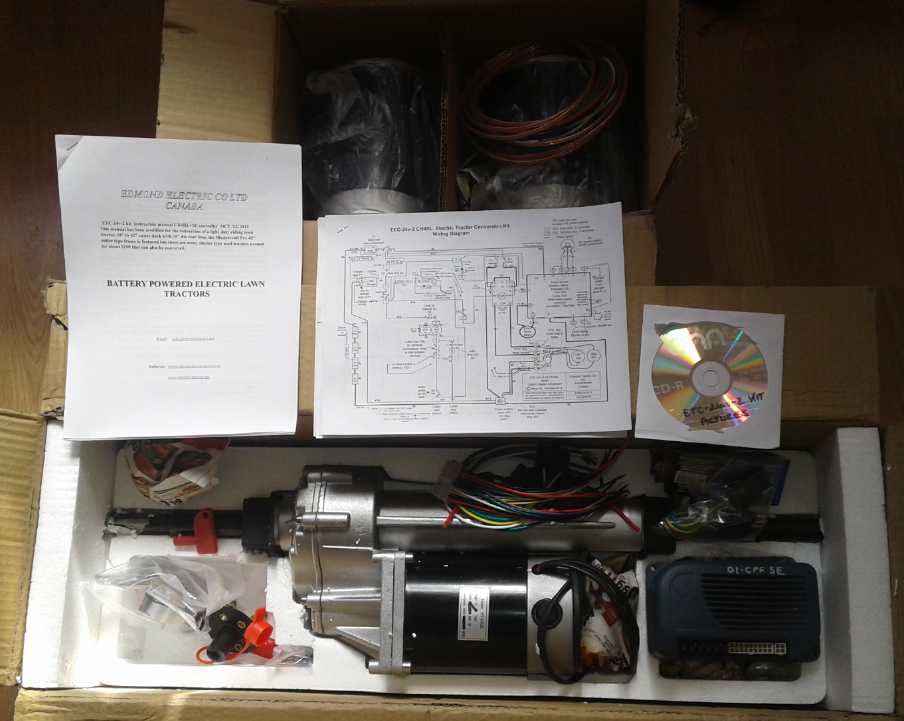 Lawn tractor electric conversion kit
Lawn tractor electric conversion kit
Gardening: Window Greenhouse
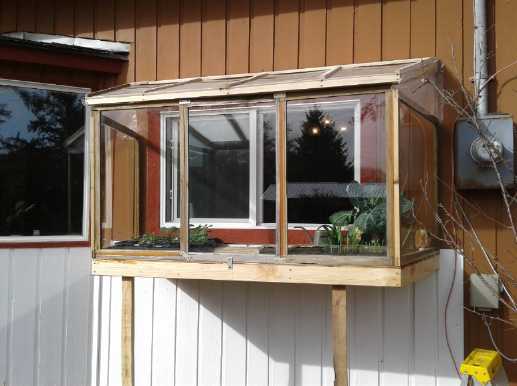 At the
refuse transfer station I lucked out and found 5 nice thin single pane
windows with cedar frames. I decided to make a "window box" greenhouse
for seedlings and potted
plants. I had a large south facing window that slides open. It soon
proved great for seedlings in the spring - at least on days when the
sun appeared. With efficient LED lights there seems little point trying
to keep such a heat-sucking space warm in cold weather and I'll stick
to the "Indoor LED Garden" for winter. (see In Passing, below,
for more detail) Qt night my seedlings are getting "hardened off!" Day
by day I get a couple more of them planted.
At the
refuse transfer station I lucked out and found 5 nice thin single pane
windows with cedar frames. I decided to make a "window box" greenhouse
for seedlings and potted
plants. I had a large south facing window that slides open. It soon
proved great for seedlings in the spring - at least on days when the
sun appeared. With efficient LED lights there seems little point trying
to keep such a heat-sucking space warm in cold weather and I'll stick
to the "Indoor LED Garden" for winter. (see In Passing, below,
for more detail) Qt night my seedlings are getting "hardened off!" Day
by day I get a couple more of them planted.
Chicken Sled
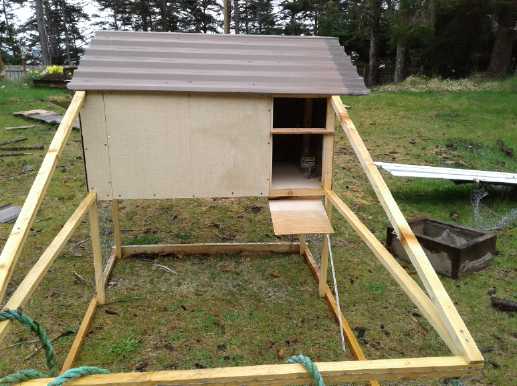 I started on
this lightweight coop just days before the chicks arrived. The idea is
to tow it across the lawn day by day to give the occupants fresh places
to forage, "free range" sort of, and save on feed. In my mind making it
was trivial. In fact it took a lot longer to make then I expected. In
the morning I would decide to do whatever piece was next on it and end
up working on it all day. While much smaller, I think it wasn't so much
less work than adding a room onto a house. Partly, I was cutting and
shaping the lumber pieces for it as I went, small dimensions so it
wouldn't be too heavy. (eg, 1.25" square) (Also see "Chickens" in In
Passing, below.)
I started on
this lightweight coop just days before the chicks arrived. The idea is
to tow it across the lawn day by day to give the occupants fresh places
to forage, "free range" sort of, and save on feed. In my mind making it
was trivial. In fact it took a lot longer to make then I expected. In
the morning I would decide to do whatever piece was next on it and end
up working on it all day. While much smaller, I think it wasn't so much
less work than adding a room onto a house. Partly, I was cutting and
shaping the lumber pieces for it as I went, small dimensions so it
wouldn't be too heavy. (eg, 1.25" square) (Also see "Chickens" in In
Passing, below.)
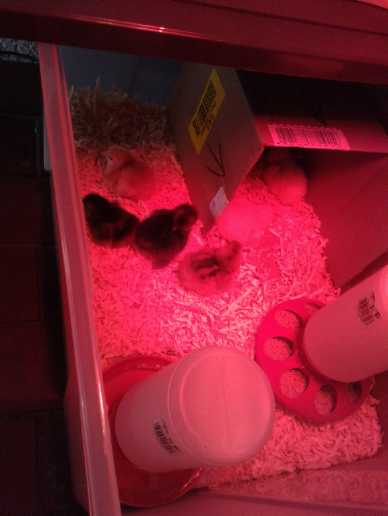 Day old chicks under red incubator lamp
Day old chicks under red incubator lamp
Compressor Design for Open Loop Air
Heat Pumping
I came up with a new, rotary, design for a
compressor-decompressor. At first I thought "Bellows!" There was a
compressor with almost no friction, and no sliding seals! Then I
thought of the "ROVAC" design. If one could have a rotating cam
pressing and releasing sets of bellows there'd be no need for those
nasty seals around spaces that were changing shape as it turned. But
then I started having trouble imagining any bellows material that would
stand up to continual flexing and changing pressures.
That brought me back to pistons. But maybe instead of just
two pistons (compression and decompression pair), one could could use
the rotary shape with cams to move the pistons in their cylinders; any
number of pairs of compression and decompression pistons.
I may yet come up with something better, or at least get
more sophisticated with this basic design. It seems to me slippery,
dense UHMW plastic might make good piston rings and other sliding parts
with minimal friction. And the layout might possibly be axial instead
of radial. (Is there any way to make it so the moving parts ride on a
thin cushion of air against each other to eliminate friction and wear?)
Or there still may be some way to do some sort of modified 'bellows'
design. I haven't settled on anything at this point. (Also see under Other
"Green" Electric Equipment Projects.)
Miles Truck Battery Restore
One electric "project" I did spend some little time on was
trying to restore the "golf cart" batteries in the Miles electric mini
cargo truck. Last fall some time, I had plugged in the truck's
"Delta-Q" 72 voly charger to top up the batteries. I forgot about it.
It decided to spend two weeks boiling the water right out of the cells
at the maximum possible charge current. Thanks a lot! In fact it was in
wondering why my daily electricity usage had risen so much that I
finally remembered about the truck and shut it off. But there it sat. I
considered putting the 100 amp-hour lithiums into it.
35 of the 36 cells had no visible sign of liquid looking
at the plates through the top holes. It took nine liters of distilled
water to refill them.
Then I put the little 2 amp pulse chargers on them, but
they just said "Bad Battery" and wouldn't even try to charge them.
Thanks a lot! I got out a lab power supply to start raising the voltage
and got a couple of 12 volt sections started.
At some point I thought of the 6 chargers I had bought
from Canadian Tire, that had tried to fry my lithiums. They were
pulsers, so they should be good for lead-acid golf cart batteries. I
looked and noticed they had a 2 amp - 10 amp switch setting. Oh... 2
amps would be ideal. Improvidently I had in the last month just sold
two of them to other people having trouble with golf cart batteries! I
should have used them for the truck, charging each 12 volt section
separately to replace the diabolical Delta-Q -- really what I had
originally bought them for. It wasn't until the 26th, at least two week
after I had refilled the cells, that I had all six pairs charging at
once. With 180 amp-hour cells charging at 2 amps it was going to take a
while, but if they really could be restored it would be worth it.
My thoughts are that if the supply lines really are
disrupted in the future, there may be no petroleum fuel at any price,
and the electric truck could be invaluable for carrying local produce
to town. I would mount three 305 watt solar panels on the roof and
charge the batteries in three separate 24 volt sections with PWM
(pulse) chargers. As long as these old lead-acid batteries last. If
they're still any good now!
Of course I would replace the clunky transmission with the
planetary gear I bought for it, reprogram the controller a bit, and get
it up to about 60 Km/Hr instead of 40 - yet another project I can't
seem to get to.
Ground Effect Vehicle
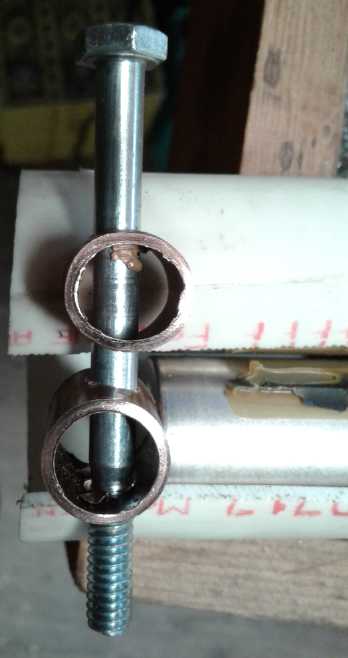
 I blush to
report how little again I did on projects. Here' what little I did do
on this: I figured out how to make connections to the slit plastic
"tubes" of batteries I created in March.
I blush to
report how little again I did on projects. Here' what little I did do
on this: I figured out how to make connections to the slit plastic
"tubes" of batteries I created in March.
That method was to put a bolt across each end, and use
pieces of copper (pipe) that could be bent a bit to make them even and
provide tension to hold both "flashlight tube" rows of cells all in
contact with each other.
The wires will have to solder onto the copper pieces on
the stainless steel bolts inside the tubes, because if the bolts stick
out even a little more to clamp a wire on the ouside, the stick is too
wide to fit into the hull. (So I've made a copper tube to fit over the
bolt on the "+" side, too, to solder the red wire to.)
(That #8 AWG stove wire is sure stiff and heavy. The
"plus" lead then has to go to a 100 amp breaker/shutoff switch before
the "ESC" motor controller. Supposedly they can draw 120 amps. I can't
believe the "22.6" volt batteries will deliver that much!)
I hope it doesn't take me another month just to do the
second one for the other hull! Everything I want to do feels like I'm
swimming through molasses or something.
In Passing
(Miscellaneous topics, editorial comments & opinionated rants)
Gardening &
Chickens
Window Greenhouse
 I
continued my gardening in
preparation for the time when food will doubtless be scarce. Along with
everything else, this island is at the end of the supply chain for what
it doesn't grow itself. No doubt even deer will become scarce if food
gets short. At the
refuse transfer station I lucked out and found 5 windows with thin
(3mm), single glass and nice cedar frames. At first I thought to
improve the largest greenhouse by replacing some of the "Solexx"
plastic that doesn't let much light through with clear glass. Then an
idea occurred to me to make a "window box" greenhouse for potted
plants. I had thought of this decades ago when I lived in Victoria, but
it seemed to me there wasn't enough sunlight in the winter to grow
anything anyway. (I remember reading in a magazine when I was pretty
young (at least 15 years BI - before internet) about "growing tomatos
in winter" in a window box greenhouse. It said "they do need at
least 8 hours sunlight even in December." I thought "Even cloudy
Victoria gets
that!". After getting all excited about building one I realized the
author really meant per day in December, not for the whole
month, and the intended locale must be considerably farther south and
certainly
not on the cloudy west coast.) Now we have efficient LED lights for
winter.
I
continued my gardening in
preparation for the time when food will doubtless be scarce. Along with
everything else, this island is at the end of the supply chain for what
it doesn't grow itself. No doubt even deer will become scarce if food
gets short. At the
refuse transfer station I lucked out and found 5 windows with thin
(3mm), single glass and nice cedar frames. At first I thought to
improve the largest greenhouse by replacing some of the "Solexx"
plastic that doesn't let much light through with clear glass. Then an
idea occurred to me to make a "window box" greenhouse for potted
plants. I had thought of this decades ago when I lived in Victoria, but
it seemed to me there wasn't enough sunlight in the winter to grow
anything anyway. (I remember reading in a magazine when I was pretty
young (at least 15 years BI - before internet) about "growing tomatos
in winter" in a window box greenhouse. It said "they do need at
least 8 hours sunlight even in December." I thought "Even cloudy
Victoria gets
that!". After getting all excited about building one I realized the
author really meant per day in December, not for the whole
month, and the intended locale must be considerably farther south and
certainly
not on the cloudy west coast.) Now we have efficient LED lights for
winter.
My present house has exactly one large south facing window
that
opens. It would be perfect. I figured that would have some advantages
over a regular
greenhouse:
* It is small. It can be crammed full of potted plants - greens, herbs,
tomatoes, peppers, onions, my coffee bushes...
* If one desires to keep it warmer - either to stay above freezing or
to where plants will actually keep growing - one merely cracks open the
window into the house. Ditto the house window can be opened if it's too
warm in summer. Since bugs can't get in, the window needs no screen.
* Can be used year round.
* Makes full use of natural light. (Of course LED grow lights could be
added for winter.)
* It is accessed from inside the house. When you want something for
supper, it's close. Deer and mice can't get in, nor slugs, nor hungry
garden raiders who didn't prepare if such should make an appearance.
(If they do they might get a lot of my other produce, from the garden
and regular greenhouse.)
It would also have disadvantages:
* Dirt and gardening stuff has to go in and out through the house, in
this case, the livingroom.
* In spite of this one being quite large for what it is, it's not a
very big growing space. It's not a replacement for a large greenhouse.
* And it's not tall enough for tall plants.
* And if it's too full it'll be hard to inspect and water. The far
right hand side, especially, is going to be hard to reach.
* Plants in pots can't be neglected long or they'll dry out and die.
Plants in the ground put down longer roots and can tolerate some drier
conditions. (Some of my seedlings in tiny 'pots' died from missing
watering just one day, when they were probably also watered too lightly
the day before. Others survived but were wilting. Still others were
fine. ...and it I don't get up and look at them now, they'll miss
today,
too.)
* Unless it can be opened, pollinating insects can't get in.
With glass windows for front and sides, what about a roof?
To make a long story short, I found I had two 2x4 foot plastic light
diffusers. Once upon a time I had bought them for making LED lights.
Now they
made 2/3 of a roof. I wished I had three. It would have been perfect. I
split one down the middle to make narrower top sections. I didn't know
how I would finish it, then I realized I had more in the form of three
1x4
foot fluorescent light diffusers that had been replaced and I hadn't
thrown out the diffusers. The plastic from two of those made up for the
missing third
piece, just right to finish the roof. Now if only I hadn't split the
other piece, since these two were already split! Oh well, so it ended
up
with an extra overlapping join. I just stapled up some small triangle
pieces of polyethylene from a roll for the top of the sides.
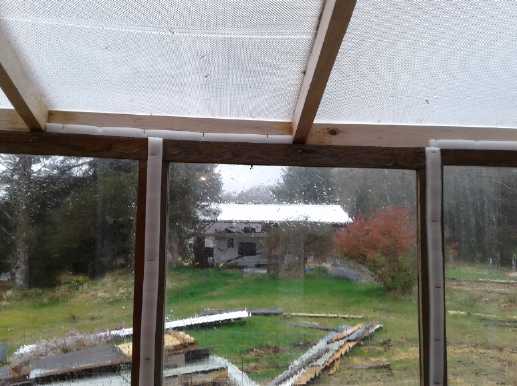 In practice it seemed quite nice. It got nice and warm when the sun
was shining and was about neutral in clouds. But the cold draft coming
through once the sun departed led me to close the window most of the
way at night. I stapled in some polyethylene foam plastic as
weatherstripping, but unless I can make
it much better, or unless I get super cheap heat pumping going, I
think I'll forget about trying to keep it warm in winter.
In practice it seemed quite nice. It got nice and warm when the sun
was shining and was about neutral in clouds. But the cold draft coming
through once the sun departed led me to close the window most of the
way at night. I stapled in some polyethylene foam plastic as
weatherstripping, but unless I can make
it much better, or unless I get super cheap heat pumping going, I
think I'll forget about trying to keep it warm in winter.
Other Gardening
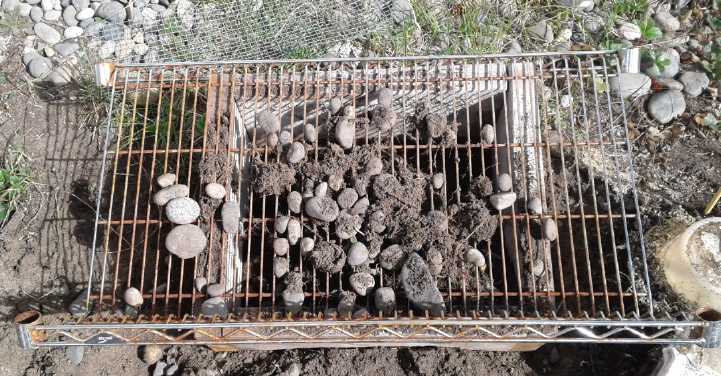 Usually rock sieves are made from a square wire
mesh. I had this grill sitting around and thought
Usually rock sieves are made from a square wire
mesh. I had this grill sitting around and thought
it might let the dirt through more easily while still stopping the
rocks. It sort of works, but it
lets a lot of flat or flattish rocks through. If the soil has mostly
rounded or chunky rocks, it's
probably better than a square mesh.
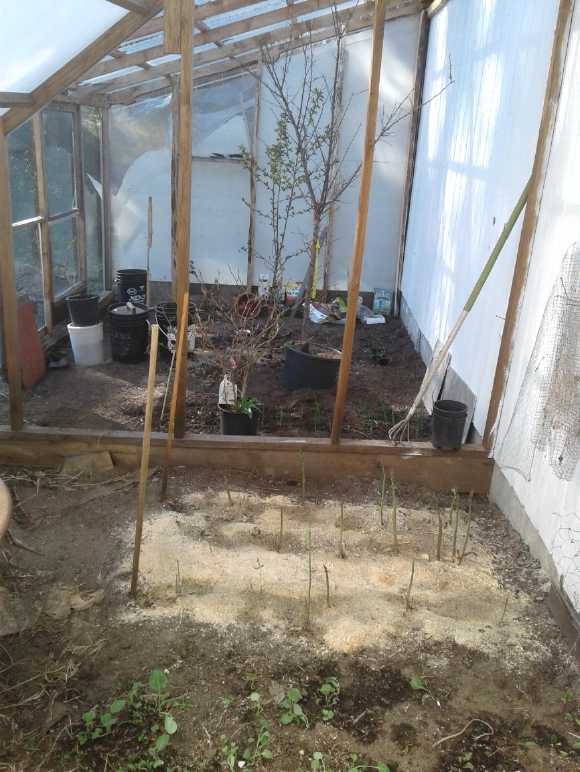 A shot of my greenhouse mid April.
A shot of my greenhouse mid April.
Some cabbage and beets in the foreground reseeded themselves this year.
(Thinnings go into salads)
The asparagus seems well established (3rd year). They are thick and
juicy.
Past the dividing wall are a couple of rows of onions from sets.
At the west end (that gets more shade from trees) I planted a cherry
tree and then an apricot (here still in pot).
Close up and unseen off to the left, my 3 year old cabbage is producing
flower bud
clusters that taste like broccoli. So I won't pull it up until the
space is needed
or the flowers all bud out.
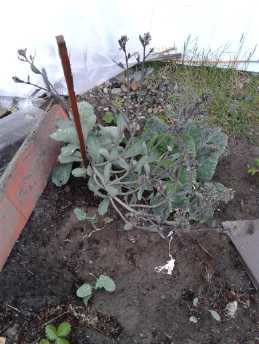 Here's what the cabbages outdoors do around
here: they grow no head,
Here's what the cabbages outdoors do around
here: they grow no head,
but in the second year they grow 5 feet tall and 8 feet long and bushy,
flower,
and produce enough seeds for a farm field. This one is hardly getting
started, I'm sure.
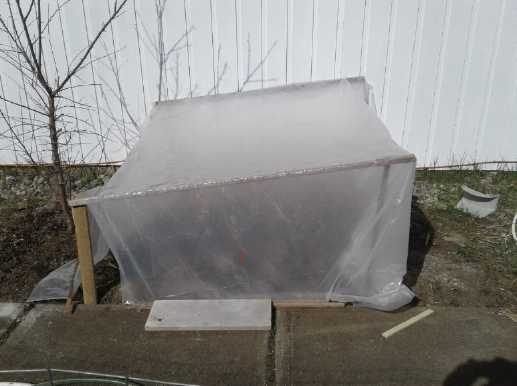 When I didn't seem to have room in the
greenhouse, and with corn outdoors
When I didn't seem to have room in the
greenhouse, and with corn outdoors
last year being a total flop, I thought I'd make a plastic cover,
weighed down
along the bottoms with pieces of wood stapled to it. The back is
attached to the house.
(I also note a store was selling "early-something" corn seeds. Why did
I not buy some of those,
since the here summer just doesn't seem to be long and warm enough for
typical varieties?)
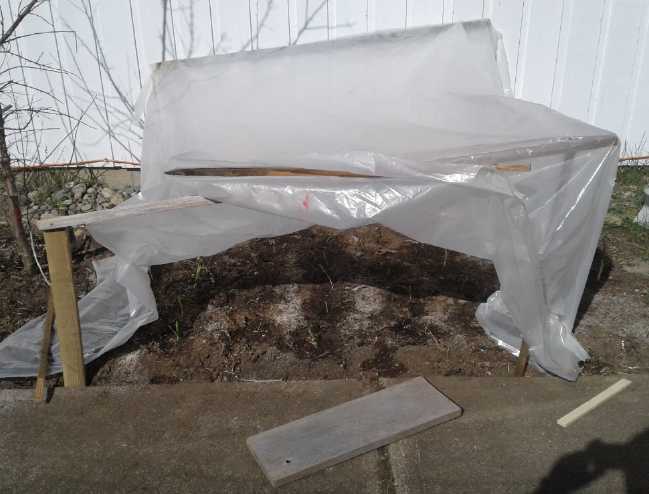
It worked well for a couple of weeks, then a wind lifted
the cover off and started banging it around in the vegetables and the
corn. I had to take it off. I haven't come up with another plan except
to put some rigid plastic seedling tray covers over some of them (with
a rock on each one for weight). After 10(?) days, the ones under the
covers are notably taller than those in open air.
Chickens!
 On the 21st the store called to say the baby chicks I had ordered the
previous month had hatched. I can't believe they all had the same
parents - two yellow, two somewhat stripey and two pretty dark. That
seemed like a good assortment. By the time I got them home the little
cardboard box was chirping piteously. I set up a plastic tote with
food, water and a heat lamp (all bought previously when I ordered them)
and once they had warmed up they seemed content.
On the 21st the store called to say the baby chicks I had ordered the
previous month had hatched. I can't believe they all had the same
parents - two yellow, two somewhat stripey and two pretty dark. That
seemed like a good assortment. By the time I got them home the little
cardboard box was chirping piteously. I set up a plastic tote with
food, water and a heat lamp (all bought previously when I ordered them)
and once they had warmed up they seemed content.
Evidently after a month it'll be time to move them out to
the chicken sled I had just started building. If that works and nothing
gets in and eats them, in six months they should start laying.
Depending on how many are hens. If there's more than one rooster I'll
have some chicken dinners. (More likely there'll be 3 or 4.) If there's
more than two hens I'll probably sell some eggs now and then.
The idea of the chicken sled is a portable coop I can drag
around the yard and let the chickens forage in a different place every
day (without letting them out where the hawks would surely get them).
A neighbor that works at the store says the price of the
feed is going up rapidly. I had already bought four big bags - I knew
I'd be getting chickens sometime soon. Finally it seemed like time -
and it turned out it was almost past time as chicks that were supposed
to arrive by air from breeders elsewhere were canceled along with all
the flights. I was probably lucky to get some this spring. Hopefully
the sled will greatly cut down on the added feed required.
(On the 25th, out of the blue, one chick was killed.
Apparently that happens. Maybe I needed a bigger incubator box? Now I
have five, at least one of which is a homicidal maniac.) Skipping
ahead, by the end of the month it looked like they were starting to
peck at each other again. Getting too crowded as they grew, I assume? I
had the penthouse suite on the chicken sled enclosed by then and I
moved them out there, with the incubator light, where they once again
seemed fairly content.
The chicken sled construction continued once I had them.
It took a lot more time than I expected. I guess the size of a
structure only makes so much difference as to how much work it is.
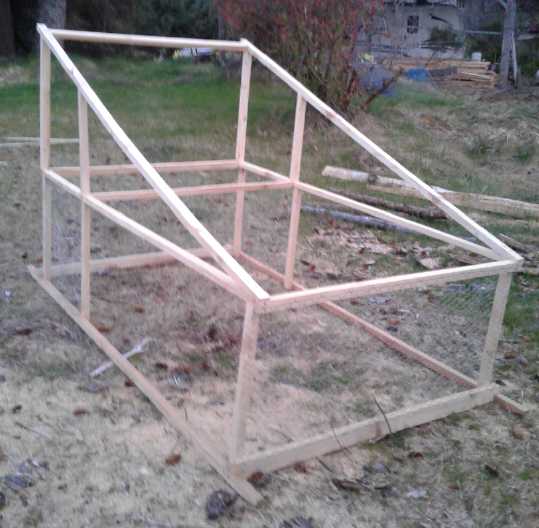 I started with the idea of an ultra-light 2
foot tall frame on "skis" with
I started with the idea of an ultra-light 2
foot tall frame on "skis" with
chicken wire around it and a vague idea for a small coop sitting on top.
Then I decided to integrate the coop with a slanted top to give them
more
vertical space within the enclosure. (Maybe add a perch in the taller
area?)
(Really it wouldn't have weighed much more or been any harder to make
just
to have made it 4+ feet tall all around. In fact, probably easier to
make
without the odd angles. But I didn't have much of a plan. Hindsight!)
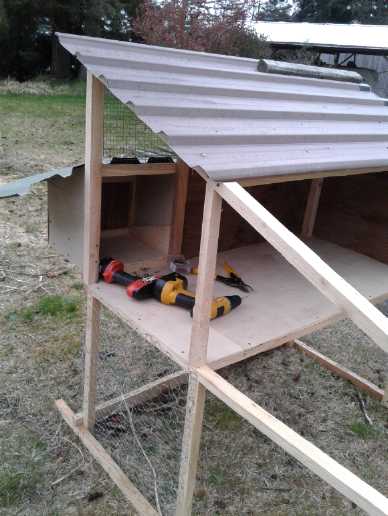 So I started closing in the coop: 1/4" plywood
floor, 1/8" walls.
So I started closing in the coop: 1/4" plywood
floor, 1/8" walls.
And of course a nest box on the side. I put it just inside my
access door so the roof didn't have to open. (I'll find out if that
proves inconvenient.)
I put the roof sheet "sideways" to drip off the ends instead of into
the enclosure.
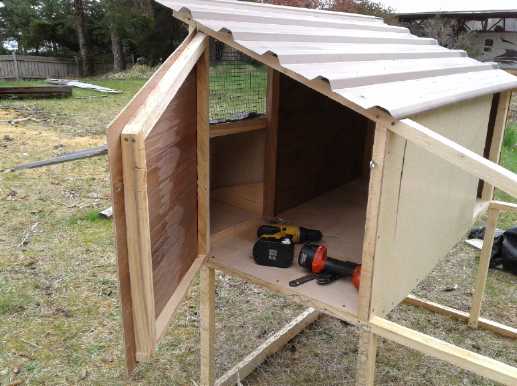
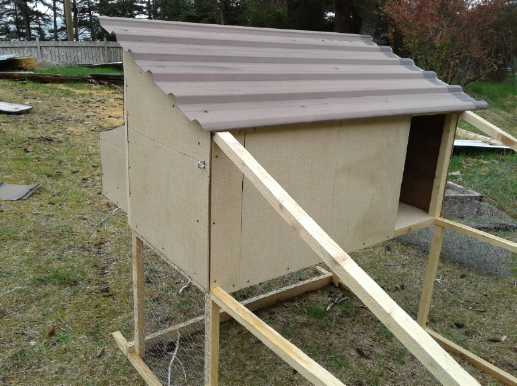 Penthouse suite
Penthouse suite
Chicken
door drops down by gravity with piano hinge behind.
Treadle operated from inside, or
manual
 I had been looking at "automatic
chicken coop doors" on line. I finally decided they didn't fit in with
my sled. Instead I'd make a door that the chickens open by stepping on
a peddle as they start stirring in the morning. I'll still have to
close it at night. (Darned if I'm getting up at the crack of dawn to
open a door for some chickens!) But I may make my own electronic one at
some point. Or buy one if it's still possible.
I had been looking at "automatic
chicken coop doors" on line. I finally decided they didn't fit in with
my sled. Instead I'd make a door that the chickens open by stepping on
a peddle as they start stirring in the morning. I'll still have to
close it at night. (Darned if I'm getting up at the crack of dawn to
open a door for some chickens!) But I may make my own electronic one at
some point. Or buy one if it's still possible.
The chicken sled is still light enough to easily drag
around in the yard to give the chickens a new place to forage every
day. (They can go to work clearing and fertilizing some new garden
space.)
Meanwhile, warnings have been coming in from "Ice Age
Farmer" and "Adapt 2030", and others on youtube started saying that
shortages of meat are "weeks, not months" away, and on the 23rd: "as
little as two weeks away". On the 25th another youtuber warned '...one
week away - if you want pork, get it now.' These may be a little overly
alarmist, but when it's in short supply, all the other meat will
skyrocket in price and get scarce too. (It seems it also varies by area
- that there are more bare grocery store shelves in Eastern USA than in
the west.)
With rapidly rising food prices along with the "to
infinity, forever!" money printing printing now going on, the stage is
well set for hyperinflation, the demise of present day fiat currencies,
and probably at least a partial collapse of the supply chain owing to
the financial collapse - everything runs on credit. (I don't suppose
the OAP I've just started getting will buy much soon. Precious metal
prices are rising now as people start to get out of fiat, with long
delivery delays and apparently are hard to get in any quantity.) I may
be really relishing the produce, chicken dinners and the eggs, by the
time things are coming ready!
Gingko
(or Ginkgo) Biloba for Better Memory
For decades I used to do things like go out to the shed
for something, and on my way out, by the door I would see something
that was there to be put away in the shed next time I went out, so I
would take it with me. I would put it away and go back in the house
without doing or getting what I had gone out to do or get. Back in the
house I would remember of course, and have to go out again.
A few years ago I started taking gingko biloba supplement
pills, from the ancient bi-lobed tree originating in the Permian period
before the dinosaurs (the oldest living seed bearing tree?), and
reputed to help with memory by improving blood flow in tiny capillaries
such as within the brain.
Nowadays I'll do the same thing, but at latest and at
least, just as I start back into the house, if I haven't set about
doing what I had intended, I'll remember that I was out there for some
reason besides putting an item away. Then at least when I think about
it for a moment, I remember what it was I came out to do.
While one cannot unequivocally assign cause and effect to
this, it does seem to me that if the gingko isn't what's helping, I
must be just getting "less senile" with age.
I have a perhaps humorous story with getting it for the
first time. I had read about it in a book on supplements, 3 or 4 of
which I had started taking. I was in a drug store in the vitamins
section and started searching the shelves for... what was it again?
"Can I help you find something?" an employee nearby asked. I said,
"Maybe, except that I can't remember what it's called." I continued my
search and recognized the name when I saw it. "Ah, here it is, ginkgo
biloba." I said. "Now if only I could remember why I wanted it." I'm
sure she must have thought I was joking, but I remembered nothing about
it except that I wanted to get it and start taking it because it was
recommended in the supplements book I'd just read. I had to read in the
book again that it was to improve memory, and recognized the irony.
Small Thots
* Some time back, people had been posting that some of the fires in
Fort McMurray and in California didn't seem natural and thought that
they had been ignited and spread artificially. They sounded very
convinced, and I was seriously thinking for quite some time they might
be right. OTOH, what would be the motive? Would the US military really
do that to test new weapons or to execute some government agenda? Then
too, could it be that there have all this time been no leaks exposing
the plot? The more I thought about it, the less likely it seemed.
Recently I saw in a video of TV news a stand of dry
evergreen trees in Australia during their fires. The fire caught at one
end and the whole row of trees downwind was ablaze in a matter 2 or 3
more seconds. I no longer need any "conspiracy theories" to explain the
amazing spread of fires in dry conditions. And then I was thinking
about the metal in the posts, where the metal had charred the wood,
which was otherwise not very burned. Well, if there was a fire burning
around those signs and highway guard rails, the sheet metal with its
large surface area would heat up quickly and transfer its heat to the
bolts, then the wood would start to char around the metal and the bolts
even if the rest of the post wasn't much affected. So we have the
fallen metal signs and guard rails, burnt off their wooden posts.
I still do have questions. Did the California governor
really veto a dead wood cleanup bill passed unanimously by the
legislature, as was reported in those videos? If so, why? Of course it
would have cost money, but cleaning up a lot of dry, dead tinder would
have obviously mitigated the spread and horrendous damage of those
fires. And, with fire all around the main roads in and out as shown in
videos by survivors, and all those burned out vehicles and homes, were
there really so very few casualties as reported on the news, or were
there bodies everywhere in the town afterward as the videos claimed
some truck drivers that went in soon after had reported? There were
certainly melted down cars parked on the streets. Did almost everyone
actually make it out? It seems to me that in the Bahamas where
virtually the whole of the islands were flooded out and all the
habitations destroyed in the hurricane, that the puny death toll
reported in the news must bear little resemblance to reality.
* Someone not that long ago said in the course of a video he had had to
do something with dead bodies that had been shot during Hurricane
Katrina. They might have been looters, but there were enough that he
had the impression they must have shot prisoners in the jail rather
than let them out or try to take them somewhere. But he didn't really
know. I just hope that if it's true, it was only the ones who should
have been removed from the planet anyway instead of languishing
warehoused away for decades or for life at public expense.
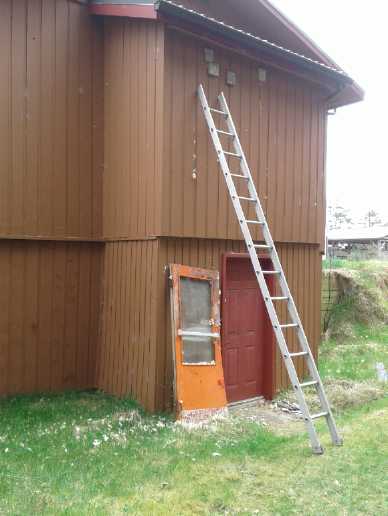 * A redheaded
woodpecker decided to start in on the back end of my house. I went out
and chased him off a few times, but he came back daily, early in the
morning, and started in again. ("Pellet gun" was suggested.) After a
couple of weeks he had a couple of big holes and had flung out little
bits of fiberglass insulation - all over, everywhere. Apparently he was
trying to make a nest but didn't like the stuffing. Finally I had had
enough and I went up on a ladder and screwed bits of wood over his
larger holes. Then I went out with the vacuum cleaner and eventually
managed to suck up all (?) the bits of insulation. (Yes I should deal
with that old door, too.)
* A redheaded
woodpecker decided to start in on the back end of my house. I went out
and chased him off a few times, but he came back daily, early in the
morning, and started in again. ("Pellet gun" was suggested.) After a
couple of weeks he had a couple of big holes and had flung out little
bits of fiberglass insulation - all over, everywhere. Apparently he was
trying to make a nest but didn't like the stuffing. Finally I had had
enough and I went up on a ladder and screwed bits of wood over his
larger holes. Then I went out with the vacuum cleaner and eventually
managed to suck up all (?) the bits of insulation. (Yes I should deal
with that old door, too.)
I decided this woodpecker was not environmentally
friendly, casually tossing all that artificial fiber all over the place
to blow around in the wind. He came back a couple more times. I
immediately went around back and chased him off both times, and that
seemed to finally discourage him.
* From the Web: - This won't be the last
or Worst Pandemic
https://time.com/5820607/nathan-wolfe-coronavirus-future-pandemic/
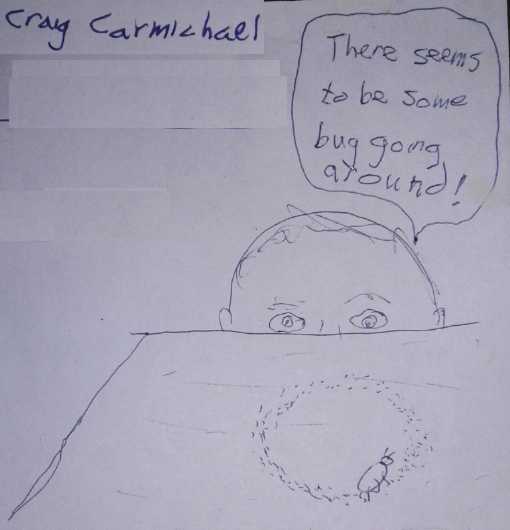
* From the Web: - Our democracy no longer represents the people. Here's
how we fix it | Larry Lessig | TEDxMidAtlantic
https://www.youtube.com/watch?v=PJy8vTu66tE
(I think my solutions are more comprehensive: HandsOnDemocracy.org
Even more "total package" solutions: http://sites.google.com/view/danielraphael/free-downloads
)
* From the Web: - The Data Is In... Stop The Panic & End The Total
Isolation
Fri, 04/24/2020 - 18:55
Authored by Scott Atlas, M.D., op-ed via The Hill
https://www.zerohedge.com/health/data-stop-panic-end-total-isolation
(To me, the shutdowns this spring look to be leading to disastrous food
shortages in the coming fall and even for a couple of years ahead.)
* Another take: - The Unseen Costs Of Government-Forced Lockdowns
(Generally Applicable!!!) https://www.zerohedge.com/health/unseen-costs-government-forced-lockdowns
"In the department of economy, an act, a habit, an
institution, a law, gives birth not only to an effect, but to a series
of effects. Of these effects, the first only is immediate; it manifests
itself simultaneously with its cause—it is seen. The others unfold in
succession—they are not seen: it is well for us, if they are foreseen.
Between a good and a bad economist this constitutes the whole
difference—the one takes account of the visible effect; the other takes
account both of the effects which are seen, and also of those which it
is necessary to foresee."
~Frédéric Bastiat
(Do we have any politicians who look ahead? It seems to me most
legislation is enacted to solve one immediate problem - or even one
possible potential problem which has not even manifested itself and is
not certain to do so - with complete disregard for "side effects" and
future effects. Whatever is done is virtually never repealed and
everyones' hands are tied more and more with each decision making a
right taken from the public and reserved to the government, who are
notorious for saying "no" when one asks for liberty to do anything.)
 * And then of course there's the main problem with
everything: the population bubble.
* And then of course there's the main problem with
everything: the population bubble.
I take exception to most of the graph. There were an estimated 50
million hunter-gatherer natives just in North America when the white
man came. So it seems unlikely that the world population was much lower
than 500 million primitive peoples worldwide even before the adoption
of agriculture. Agriculture potentially quadruples the man-land ratio,
so in the last 10,000 years the world population was likely 1.5 to 2
billion. Only "4 million" people globally at any time since humans
first evolved and spread over Asia hundreds of thousands of years ago
seems patently absurd; some sort of "urban myth". (Maybe they are only
counting people connected to the internet?)
However, the latter part of the graph with which we are
really concerned is doubtless frighteningly accurate. It looked scary
enough in the 1970s, and in the "developed world" in general we cut our
family sizes substantially. We even turned our growth rates negative.
But it seemed hardly anyone in the "third world", or even for the most
part in the "second" (except in China with their "one child per couple"
policy) did anything about slowing down their growth.
People want sex much more than they want too many children
to look after. Birth control products - and education about the whole
problem along with them - would have been the best aid we could ever
have sent to developing countries, so they wouldn't grow too large to
feed themselves in the first place. Look at the hordes of refugees now
flowing out of Africa. But that would have been proactive! It is now
much too late to prevent a global collapse with mass dieoffs of people.
ESD
(Eccentric Silliness Department)
* What is the difference between a dieagram and a killogram ?
* Ducktionary: Ducktator
1. Lords it over his fellow waterfowl
2. What to do when someone throws a spud at you
* Bird embryo that thinks it's something special: an Eggomaniac.
* Traductions des Phrases de Craig
"C'nest pas si grave": That's not a bad posse.
"Tout le monde": A flute player on tour.
"Achtung, Mimen!": Watch out for mimes! (They'll leave you
speechless!)
* Pheronomes: Little imps that are tough as nails.
* Camelot: Great place to buy camels!
* Clutter: Insidious until it become ubiquitous.
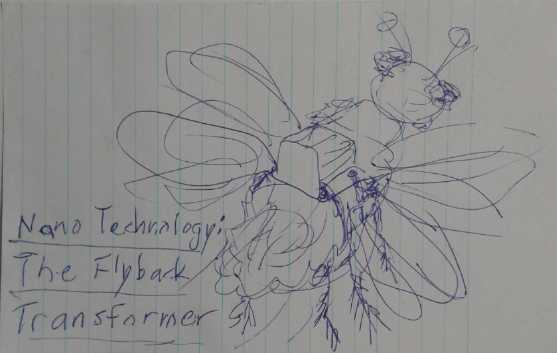
"in depth reports" for
each project are below. I hope they may be useful to anyone who wants
to get into a similar project, to glean ideas for how something
might be done, as well as things that might have been tried, or just
thought
of and not tried... and even of how not to do something - why
it didn't
work or proved impractical. Sometimes they set out inventive thoughts
almost as they occur - and are the actual organization and elaboration
in writing of those thoughts. They are thus partly a diary and are not
extensively proof-read for literary perfection, consistency,
completeness and elimination of duplications before
publication. I hope they add to the body of wisdom for other
researchers and developers to help them find more productive paths and
avoid potential pitfalls and dead ends.
Electric Transport
"Rototiller" with Lawn Tractor - Lawn Tractor Electric Conversion
The "Rototiller" Idea
I couldn't find a lawn
tractor wheel rim(s), and then I decided that changing the rear
wheels on the lawn tractor to do tilling was probably not all that
practical anyway. Could I take my idea and transfer it to a trailer to
tow behind? It still wouldn't take a lot of power to pull it.
The weight of the tractor and rider was supposed to ensure
the "shovel" bars dug into the ground as the wheels rolled. On a
lightweight trailer they would just roll over without digging in. Okay,
what about either weights on top of the trailer, or perhaps the wheel
could be something hollow, filled with water? Really it might need both.
So for wheels, I had seen some empty 20 pound propane
tanks at the refuse station. What about two of those side by side,
welded together and fitted out with the digging bars, also welded on,
and filled with water? Those seemed like a rather large diameter... the
blades might not twist far enough to loosen the dirt clods as they
turned. Was there anything longer and thinner? Maybe some big old piece
of cast iron or steel pipe?
Sizing them up at the refuse station I took a 100 pound
propane tank instead. That would be a better size to munch up a wider
swath of earth. It would hold much more water to weigh it down. I
figured that as long as the place to be tilled was within reach of the
garden hose (with any required extensions), I could tow it there empty
without it digging in much, fill it and do the job, then drain the
water out and tow it back to, um, to wherever I was keeping it. (If the
area wasn't within reach of the garden hose, how was I going to
water it?)
What really happened
But having so much to do I figured I wouldn't get to it
this spring, and I didn't know if it would give good results anyway. I
begged my neighbor with a tractor do it for me on the 19th or 20th. But
he didn't use a plow or rototiller. He used the front end loader, and a
cool rear small backhoe attachment that mounted on the 3-point hitch
(amazing - I should have got a picture!), and dug and scraped off the
whole surface layer of grass and moss, and dumped it in a couple of
piles. He dragged the front end loader over it "claws down" to smooth
it off and drag out more clods of roots. We found a couple of big ones
from the nearby spruce tree cut down in 2017 which I had to cut out
with a chainsaw.
I would never have got that ground ready this spring, even
if I had already made the tiller attachment! On the 22nd I planted a
row of potatoes (the shadiest row - that end of the plot ends at the
base of a three foot rise) and two rows of kamut wheat - part of my
experiment to see what varieties grow best around here. A few days
later I planted red fife wheat and then some more potatoes. I still had
3/4 of the plot to plant. (Next... More wheat, peas, and a row or two
of quinoa.)
But the next project is to build a fence around it. A deer
walked through the planted area and left deep hoof prints a couple of
times. No doubt deer would eat all the potato leaves as they come up.
Then a mouse (?) dug some holes and dug up individual grains of the red
fife wheat where the sandy digging was easiest. (Okay, the fence won't
keep mice out! I put some 1/2 inch squares wire fence material on the
ground in the worst places.)
Electric Conversion Kit Arrival
 The kit to convert a typical lawn tractor such
as mine to electric.
The kit to convert a typical lawn tractor such
as mine to electric.
All the special parts plus wiring diagrams and instructions.
The small box at the rear has two motors that directly drive the mower
blades:
No more belts and complex mechanics.
 The 24 volt motorized transaxle.
The 24 volt motorized transaxle.
I don't get excited too easily these days. But on the 11th
the electric conversion kit for the lawn tractor arrived, 10 days ahead
of Canada Post's e-mail prediction. (I wondered if it might - if
perhaps shipping volume would be down owing to so many thing being
closed. But I hear that's changed to delays as everyone is presently
ordering everything on line.) I was afraid the motorized axle was too
short, but when I measured the tractor, it seemed right. (There were
instructions for lengthening it if necessary, but it looked like a
substantial amount of work.)
So it looked great, but the next morning I decided to curb
my enthusiasm as I had too many other things to do. (Window greenhouse
done, full of plants... On with the "chicken sled" before the chicks
arrive!) The kit went into a storage room.
There were green energy projects with higher priority or
closer to finished, too... but for the most part they also had to be
set aside.
Other
"Green"
Electric
Equipment
Projects
Simple
Air
Compression
Heat
Pumping
- or -
How to Heat a Building Almost for Free
Means for Improvement?
It occurs to me that a factor in the poorer performance of
the larger Makita compressor versus the small refrigerator compressors
may possibly be "overloading" of the outdoor heat exchanger, with the
air coming in faster with insufficient time for exchanging heat, and
hence colder. More measurements of incoming temperatures from this unit
might be valuable.
In addition, some of the larger volume of air it requires
might be coming from window cracks and other air leaks. It might make a
difference to connect the incoming air from the heat exchanger directly
to the air intake of the compressor with a hose or pipe, to ensure
that's where it's getting its air from. (Didn't get to it.)
A Little Theory
One of the readers who sent me some info on air
compression and compressed air heat pumping sent me a bunch more. But I
finally got down to reading some more of the first batch.
It occurs to me: Regarding the compressed air car whose
energy was said to be from the sun, visualize a tank of air, painted
black and sitting outside in the sunlight. The tank is going to get
warmer, along with the air inside it. Since the volume is constant, the
air pressure will rise with temperature. The pressurized air can then
be used to do work, eg, directed out through a piston to drive the car
or a locomotive. And obviously, once the tank is down to atmospheric
pressure, the air can be changed for cool fresh air and the process
repeated. I don't think this is really how the compressed air car was
supposed to work, but in theory we must concede that a solar powered
compressed air car is possible. We may also see other ways of doing it
and perhaps of making high COP use of the air.
The book's subject was compressors and compressed air
engines, so their thrust is a little different than for heat pumping.
They suggest that the cooling of decompression and the heat of
compression can be put together to annul and prevent the undesirable
heating of the compressor and cooling of the engine. But for heat
pumping, we want to keep them separate: the compressor should pump as
much heat as possible to be applied as warmed air to the radiator
pipes, and then as much heat as possible is to be extracted from those
before the coldest possible air is sent to the great outdoors, having
delivered the maximum possible amount of heat into the building, and
then (given a special compressor) having also given up its pressure
energy to assist with the compression of the incoming air.
Some Notes:
The amount of heat energy
required to raise the temperature of one kilogram of air by one degree
(C or K) is .276 watt/hours. (And IIRC air at sea level is around 2 Kg/m^3)
Ideal gas law: P*V = n*R*T
Where P is pressure, V is volume, n is the amount of gas (in "moles":
6.02*10^23 molecules), R is the ideal gas constant for
putting everything in the desired units, and T is the temperature.
R = .08314 Bars*Liters / Moles*Degrees-K
---
For what seems like a pretty simple, straighforward
relationship between changes of volume, pressure and temperature of a
gas (air), the overall situation actually starts to get rather complex.
It is noted that in adiabatic air compression, that is, where the heat
of the air is retained during compression, as the air is compressed, it
is also heated, which further raises its pressure. If a quantity air is
suddenly compressed into half its space, the pressure is doubled... but
the temperature is also doubled. Doubling the temperature also doubles
the pressure. So then the pressure is actually multiplied by four. So
if we are measuring the pressure and double it, we are not doubling the
quantity of the gas.
According to the book a ratio of 1.406 applied: if an
energy of 1.406 units is applied to adiabatically compress air, the
energy in that air consists of 1.000 units in the increased pressure,
and .406 units in the extra heat energy of the air. I wondered where
this figure came from.
Instinctively I suddenly thought it should be the square
root of 2: 1.414 rather than 1.406... which figure (looking again at
the book) was apparently taken from measured values and calculated with
some numbers of only 3 digits precision. If one compresses air to
1/1.414 of its volume, then P*T = 1.414*1.414 = 2 : pressure has been
doubled with compression and increased temperature, each the square
root of doubled. Suddenly the theory added up! 1.406 may also have been
derived from the fact that no gas is actually an "ideal gas", but for
the sake of clarity I'm going to use 1.414 for now.
So our efficiency of the compression to pump heat is .414
/ 1.414 = 29%. (Using 1.406 also rounds off to 29% anyway.) So only
2/7ths of the energy is heat. Once the heat has been dissipated, the
other 5/7ths of the energy is still available in the compressed air.
(This would assume the air is the same temperature as it went in at. We
have actually extracted still more heat via the outdoor heat exchanger
and it is colder. So it has yielded more then 29% of its energy as
heat.) In a system with a regular air compressor this 5/7ths of the
energy hisses out the exit valve outdoors, wasted.
So if we had a theoretical possible COP of 30 from having
a temperature lift of 10°C, 29% efficiency immediately drops it to
8.7 even if everything else is perfect. This starts to give a glimmer
of why the regular air compressor gives poor performance.
If we make a compressor that utilizes the exiting air to
help compress the incoming air, we gain 71% (or say 67% since the air
is colder), or in other words the compressor only needs 33% as much
energy as a regular air compressor. This doesn't sound as good as my
previous estimates, but it still gives 8.7 / .33 = 26 theoretical COP
before various mechanical losses.
The application in the book was for compressing air for
later use by a compressed air engine, and notes that the compressed
air's heat energy is lost because it cools before it is used.
Here we use the heat energy and it's the compression energy
that mustn't be wasted.
My big takeaway is that it doesn't change my essential
conclusions from all the experiments:
1. Open loop compressed air heat pumping employing an outdoor heat
exchanger should be possible and effective with some very high COP.
2. In order to get a very high COP figure, a specially made air
compressor/decompressor must be utilized.
3. With allowance for the law of diminishing returns, the better the
outdoor heat exchange, the higher the COP will be even at very cold
outdoor temperatures.
Rotary "Bellows" Heat Pump Air Compressor/Decompressor?
So again, what might an appropriate compressor for heat
pumping look like? The ROVAC had some appealing aspects, but the seals
of the sliding vanes seemed almost problematic. I discovered in a bit
of the new material that a similar compressor for refrigeration ran at
25000 RPM. That explained how it could be done at all: the air was
pushed through so fast it didn't have much time to leak out. In the
ROVAC also the spinning cylinder was pushing almost horizontally on the
vanes where they had to slide vertically, so there must have been a lot
of friction.
I thought of a bellows, the manual air pump "accordion"
device for blowing air onto a fire. It only has one air inlet and one
outlet. Other than that it's a sealed unit. If something conceptually
along those lines was placed within a rotary device, an elliptical
rotor (or perhaps one with a cam or cams) could press on the bellows
and activate it. There wouldn't have to be sliding seals on the
rotating mechanism. (Hereinafter I'll call this a "bellow unit")
Then, if there was another opposite bellow unit whose
input was the compressed air side (the cold but still compressed air
after heating the radiators and outdoor heat exchanger), it would be
pushed open by that air and so the expansion of that air would help
turn the compressor.
Any number of cams could activate each bellow unit any
number of times per rotation. Likewise, any number of pairs of
compressing/decompressing bellow units could be activated by each cam (
or pair of cams). If more than one pair of bellow units were offset to
operate at overlapping times during the cycle, operation might be very
smooth. (And hopefully much quieter than a person bellowing.)
Since no seal is required, the cam(s) or ellipse can have
bearing wheels that roll across the bellows units with very low
friction. (or each bellow unit might have a bearing.) So if such
"bellows" units prove easy enough to make, this design might even prove
to be more efficient (have lower losses) than a piston type... or maybe
even than any other type?
Should it prove difficult to make suitable and long
lasting self-sealed "bellows" units, perhaps each one could be replaced
by a piston and cylinder, which would be activated by the cam. This
would have the friction of the piston seal, but that would doubtless be
less than that of sliding vanes.
The thought also occurs that each piston might do
double duty: compress air on the approaching cam, and decompress it as
the cam is going behind. A problem with that approach is that it is
then being cooled between compression-heating cycles, which seems
counterproductive in a heat pump.
(28th) I started thinking of different "bellows" arrangements. The
outer case could be a short hollow cylinder with precision sides
(ends). The moving face of each "bellows" would be slick UHMW, made to
seal well enough against those sides. Its end would be a rounded
extension of that face, which would slide into a similarly rounded slot
in the outside rim.
When the elliptical rotor face (or cam) started pressing
on the bellows face, the air trapped underneath would be pressed
through a hole on the outside leading to the radiator ducts.
As May started I started thinking that with the slick UHMW
and high precision parts (unlike the sort of parts I make), perhaps one
could go for [a cylindrical cylinder with] an elliptical rotor with
seals at the sides and on the outside where the maximum diameter was,
so it would be something like a low-leakage wall spinning around. A
thinner part of the ellipse would contact a hinged "door" or a "bellows
cover" that would fold down flat as the thicker part of the ellipse
rotated toward it. And maybe it could be two flat surfaces that come
together so that the "bellows" is pushed closed via a thin cushion of
air to reduce or eliminate friction.
But as I edit the newsletter to try and finish it, I'm
thinking of so many potential variations on a theme that my mind is
boggled. I was going to do a diagram, but I'm afraid clarity isn't
really there and it's going to have to wait until next month.
...I should continue reading the book I was sent, too.
I've certainly learned from the part I've read. Should I be so
conceited as to think I now know everything? Maybe better solutions
will present themselves?
My
Solar
Power
System
New Equipment
I was going to order another plug-in grid tie inverter and
add a couple more solar panels to the system. (It's not only cheaper
but just way more convenient than the ones you have to wire into an
electrical panel.) But I saw, and on a whim, decided to order a 5 KVA
pure sine wave inverter / 48 volt PWM (lead-acid) battery charger /
utility tie. This programmable unit will power your devices from solar,
the utility grid, or batteries depending what's available, and recharge
the batteries from solar or utility grid. A stand alone generator can
stand in for the "utility grid" if required. It is not however a grid
tie inverter: it won't send power to the utility grid from the solar
panels. (Unfortunately I didn't see a 36 volt model.)
I'm not sure if I'll be using it or reselling it later.
Month of April Log of Solar
Power Generated [and grid power consumed]
(All
times are in PST: clock 48 minutes ahead of sun, not PDT which is an
hour and 48 minutes ahead. DC power output readings - mostly the
kitchen hot
water heater for some months, then just lights - are reset to zero
daily (for just lights, occasionally), while the others are
cumulative.)
Solar: House+DC, Trailer => total KWH [grid power meter
reading(s)@time] Sky conditions
March
31st 106.26,1059.54 => 11.11 [55Km,chj; 73434@19:30] Some sun again
at last!, dull sun, and clouds. High 5°
April
1st 113.68, 1065.07 => 12.95 [73454@19:30] SUN! At last a full
sunny day! High 3°, low -2. (still feels like winter somehow.)
2nd 117.00, 1067.38 => 5.63 [73485@19:00] CLOUDY!
I
guess yesterday was a one-off. High 4°.
3rd 121.55, 1070.89 => 8.06 [55Km,chj;
73516@19:00]
Clouds, 4°. A bit of misty rain and snow to end the day.
4th 124.63, 1072.63 => 4.77 [35Km, chj;
73562@20:00] Mostly clouds, 4°, a few snowflakes.
5th 131.00, 1077.17 => 10.91 [73587@20:00] Pretty much sunny,
all day! Even a bit warm.
6th 134.87, 1079.83 => 6.53 [73608@19:30] Mostly
clouds, a little sun. But getting warmer at last!
7th 141.79, 1084.82 => 11.91 [55Km,chj; 73637@20:00] Warmer -
YAY! Also quite a bit of sun.
8th 144.25, 1086.49 => 4.13 [73672@20:30] Cloudy. A few
drops of Rain.
9th 147.57, 1088.86 => 5.69 [87691@20:00] Mostly
cloudy.
10th 155.14, 1094.80 => 13.51 [55Km,chj; 73713@2100] Sunny! (Now
warm enough to let woodstove go out during day)
11th 162.75, 1100.86 => 13.67 [55Km,Chj; 73736@19:00] Sunny. (A few
jet trails later PM.)
12th 170.06, 1106.80 => 13.25 [73754@19:00] Sunny; quite a few jet
trails.
13th 174.76, 1110.15 => 8.05 [73774@18:30] Light
Overcast.
14th 179.42, 1113.59 => 8.10 [73791@20:00] More of the same.
15th 186.30, 1118.95 => 12.24 [73813@20:30] Mostly sunny. Low
+4°.
16th 193.67, 1124.18 => 12.60 [78837@21:00] Mostly sunny, some light
overcast.
17th 199.83, 1128.85 => 10.83 [30Km,chj; 73859@19:00] Mostly sunny.
Hi +12° Lo +5°
18th 207.55, 1135.08 => 13.95 [55Km,chj; 73880@19:30] Sunny +13°
19th 210.30, 1136.93 => 4.60 [73894@19:30] Overcast
& Undercast (some fog). Hi +8°.
20th 214.94, 1140.13 => 7.84 [55Km,Chj; 73922@19:00] Overcast.
21st* ! What happened to the 21st?!? Oh ya... excitement... baby chicks
arrived! Overcast. {*est 6.5}
22nd* 225.17,~1147.5=>17.60* [73968@20:30] Overcast AM, sunny
PM {*est 17.60-6.5 = 11.10}
23rd 230.08, 1151.16 => 8.57 [73988@21:00] Cloudy.
24th 234.08, 1153.95 => 6.79 [50Km,Chj; 74018@19:00]
Cloudy.
25th 237.71, 1156.47 => 6.15 [74054@20:00] Clouds, rain,
wind, cold... sun for a few minutes.
26th 240.44, 1158.76 => 5.02 [74083@20:00] Overcast
27th 245.63, 1162.50 => 9.03 [55Km,chj; 74124@20:30]
Overcast, some rain, a little sun midday.
28th 250.08, 1165.76 => 6.97 [74156@21:00] Mostly rain
and wind, bit of sun.
29th 255.92, 1169.95 => 10.03 [74185@19:30] Mixed clouds and sun
30th 262.35, 1174.66 => 11.14 [74218@20:30] Mixed sun & clouds
May
1st 266.67, 1177.70 => 7.36 [55Km,Chj; 74252@19:30]
Mixed clouds, rain and clouds.
2nd 270.99, 1180.69 => 7.31 [74285@20:00] Cloudy
AM, sunny later PM.
3rd 276.57, 1184.77 => 9.66 [74318@21:00] Clouds, sun,
rain, clouds, sun, moon.
Daily KWH from solar panels. (Compare April 2020 with
March
2020 & with April 2019.)
KWH
|
March 2020 (11 panels)
|
April 2020 (11 panels)
|
April 2019 (10 Panels)
|
0.xx
|
-
|
-
|
-
|
1.xx
|
-
|
-
|
-
|
2.xx
|
2
|
-
|
3
|
3.xx
|
1
|
-
|
3
|
4.xx
|
4
|
3
|
1
|
5.xx
|
2
|
3
|
-
|
6.xx
|
2
|
5
|
2
|
7.xx
|
5
|
1
|
4
|
8.xx
|
1
|
4
|
5
|
9.xx
|
5
|
1
|
2
|
10.xx
|
3
|
3
|
3
|
11.xx
|
1
|
3
|
3
|
12.xx
|
-
|
3
|
1
|
13.xx
|
-
|
4
|
-
|
14.xx
|
-
|
-
|
1
|
15.xx
|
-
|
-
|
2
|
Total KWH
|
198.37
|
271.21
|
258.84
|
Monthly Tallies: Solar Generated KWH [Power used from grid KWH]
2019
March 1-31: 116.19 + ------ + 105.93 = 222.12 KWH - solar [786 KWH -
used from
grid]
April - 1-30: 136.87 + ------ + 121.97 = 258.84 KWH [608 KWH]
May - 1-31: 156.23 + ------ + 147.47 = 303.70 KWH [543 KWH] (11th
solar panel connected on lawn on 26th)
June - 1-30: 146.63 + 15.65 + 115.26 = 277.54 KWH [374 KWH] (36V, 250W
Hot Water Heater installed on 7th)
July - 1-31: 134.06 + 19.06 + 120.86 = 273.98 KWH [342 KWH]
August 1-31:127.47 + 11.44+91.82+(8/10)*96.29 = 307.76 KWH [334 KWH]
(12th panel connected on lawn Aug. 1)
Sept.- 1-30: 110.72 + 15.30 + 84.91 = 210.93 KWH [408 KWH]
(solar includes 2/10 of 96.29)
Oct. - 1-31: 55.67 + 13.03 + 51.82 = 120.52 KWH, solar
[635 KWH - from grid]
Nov. - 1-30: 36.51 + 6.31 + 26.29 = 69.11
KWH, solar [653 KWH - from grid]
Dec. - 1-23: 18.98 + .84* + 11.70 =
31.52
KWH, solar + wind [711 KWH + 414 (while away) = 1125 from grid]
2020
Jan. - 6-31: 17.52 + ------* + 10.61 = 28.13 KWH,
solar+
wind [1111 KWH from grid]
Feb. - 1-29: 56.83 + ------* + 35.17 = 92.00 KWH,
solar + wind [963 KWH from grid]
One year of solar!
March - 1-31: 111.31 + ----* + 87.05 = 198.37 KWH solar total
[934 KWH from grid]
April - 1-30: 156.09, + ---- + 115.12 = 271.21 [784 KWH
from grid]
* Solar hot water tank removed because the mineral-rich water stank.
(Why doesn't it stink in the main house tank?) Now the solar DC system
is only running a couple of lights - not worth reporting. So there's
just the 2 grid tie systems: house and "roof over travel trailer".
Things Noted - April 2020
* After the 18th (13.95 KWH) there were no fully sunny days, which
might have generated a daily 14 or 15 KWH toward the end of the month.
Whole sunny days in May (I *hope* there will be some!) should hit those
figures.
* Overall April 2019 (10 solar panels) must have been a little sunnier
than April 2020 (11 panels) to give 258 KWH.
Electricity Storage (Batteries)
Turquoise
Battery
Project:
Long
lasting,
low
cost,
high
energy
batteries
Wow... With everything ready to make what should be the
best cell so far... Sorry, no report!
Miles
Mini Cargo Truck "Golf Cart" Battery Revival
Around mid month I decided
I should either put 72 volts of 100 AH lithium cells into the truck, or
else try to resurrect the truck's golf cart batteries that had been
fried at full blast for a couple of weeks some moons ago by the truck's
own "Delta-Q" charger (some "top-up"!), and see if they would still
work and hold any good amount of charge. I had been reluctant to try
it, not enthused about the prospects, and was leaning toward just
putting in the lithiums.
I started opening the tops. 35 of the 36 cells showed no
sign of moisture looking down on the plates. One still had water. It
took 9 liters of distilled water to refill them. Then I got out some
various 12 volt pulse chargers and started hooking them up to each of
the six pairs of 6 volt batteries making up 12 volt sections. I kept
the current down to 2 amps.
To make a long story short, voltages came up - some of
them pitifully slowly, with chargers that kept deciding the 180
amp-hour batteries weren't charging and shutting off.
On May 1st, one of the chargers said "Full" and that pair
read over 14 volts. A couple of others were over 12, while the other
three were still at 10.5, 9 and 7.5.
If these batteries come back to life - or if most of them do and I
replace a couple - I seem to have made a big mistake. I had six of the
pulse chargers (switch select 2 or 10 amps), enough to charge the truck
without using the homicidal "Delta-Q", but after not using them for
about 4 years, and on finding they try to fry lithium batteries, I sold
two of them in the last month to others with golf cart battery
problems. Now I don't have the six matched chargers.
http://www.TurquoiseEnergy.com
Haida Gwaii, BC Canada


 At the
refuse transfer station I lucked out and found 5 nice thin single pane
windows with cedar frames. I decided to make a "window box" greenhouse
for seedlings and potted
plants. I had a large south facing window that slides open. It soon
proved great for seedlings in the spring - at least on days when the
sun appeared. With efficient LED lights there seems little point trying
to keep such a heat-sucking space warm in cold weather and I'll stick
to the "Indoor LED Garden" for winter. (see In Passing, below,
for more detail) Qt night my seedlings are getting "hardened off!" Day
by day I get a couple more of them planted.
At the
refuse transfer station I lucked out and found 5 nice thin single pane
windows with cedar frames. I decided to make a "window box" greenhouse
for seedlings and potted
plants. I had a large south facing window that slides open. It soon
proved great for seedlings in the spring - at least on days when the
sun appeared. With efficient LED lights there seems little point trying
to keep such a heat-sucking space warm in cold weather and I'll stick
to the "Indoor LED Garden" for winter. (see In Passing, below,
for more detail) Qt night my seedlings are getting "hardened off!" Day
by day I get a couple more of them planted. I started on
this lightweight coop just days before the chicks arrived. The idea is
to tow it across the lawn day by day to give the occupants fresh places
to forage, "free range" sort of, and save on feed. In my mind making it
was trivial. In fact it took a lot longer to make then I expected. In
the morning I would decide to do whatever piece was next on it and end
up working on it all day. While much smaller, I think it wasn't so much
less work than adding a room onto a house. Partly, I was cutting and
shaping the lumber pieces for it as I went, small dimensions so it
wouldn't be too heavy. (eg, 1.25" square) (Also see "Chickens" in In
Passing, below.)
I started on
this lightweight coop just days before the chicks arrived. The idea is
to tow it across the lawn day by day to give the occupants fresh places
to forage, "free range" sort of, and save on feed. In my mind making it
was trivial. In fact it took a lot longer to make then I expected. In
the morning I would decide to do whatever piece was next on it and end
up working on it all day. While much smaller, I think it wasn't so much
less work than adding a room onto a house. Partly, I was cutting and
shaping the lumber pieces for it as I went, small dimensions so it
wouldn't be too heavy. (eg, 1.25" square) (Also see "Chickens" in In
Passing, below.)

 I blush to
report how little again I did on projects. Here' what little I did do
on this: I figured out how to make connections to the slit plastic
"tubes" of batteries I created in March.
I blush to
report how little again I did on projects. Here' what little I did do
on this: I figured out how to make connections to the slit plastic
"tubes" of batteries I created in March. I
continued my gardening in
preparation for the time when food will doubtless be scarce. Along with
everything else, this island is at the end of the supply chain for what
it doesn't grow itself. No doubt even deer will become scarce if food
gets short. At the
refuse transfer station I lucked out and found 5 windows with thin
(3mm), single glass and nice cedar frames. At first I thought to
improve the largest greenhouse by replacing some of the "Solexx"
plastic that doesn't let much light through with clear glass. Then an
idea occurred to me to make a "window box" greenhouse for potted
plants. I had thought of this decades ago when I lived in Victoria, but
it seemed to me there wasn't enough sunlight in the winter to grow
anything anyway. (I remember reading in a magazine when I was pretty
young (at least 15 years BI - before internet) about "growing tomatos
in winter" in a window box greenhouse. It said "they do need at
least 8 hours sunlight even in December." I thought "Even cloudy
Victoria gets
that!". After getting all excited about building one I realized the
author really meant per day in December, not for the whole
month, and the intended locale must be considerably farther south and
certainly
not on the cloudy west coast.) Now we have efficient LED lights for
winter.
I
continued my gardening in
preparation for the time when food will doubtless be scarce. Along with
everything else, this island is at the end of the supply chain for what
it doesn't grow itself. No doubt even deer will become scarce if food
gets short. At the
refuse transfer station I lucked out and found 5 windows with thin
(3mm), single glass and nice cedar frames. At first I thought to
improve the largest greenhouse by replacing some of the "Solexx"
plastic that doesn't let much light through with clear glass. Then an
idea occurred to me to make a "window box" greenhouse for potted
plants. I had thought of this decades ago when I lived in Victoria, but
it seemed to me there wasn't enough sunlight in the winter to grow
anything anyway. (I remember reading in a magazine when I was pretty
young (at least 15 years BI - before internet) about "growing tomatos
in winter" in a window box greenhouse. It said "they do need at
least 8 hours sunlight even in December." I thought "Even cloudy
Victoria gets
that!". After getting all excited about building one I realized the
author really meant per day in December, not for the whole
month, and the intended locale must be considerably farther south and
certainly
not on the cloudy west coast.) Now we have efficient LED lights for
winter.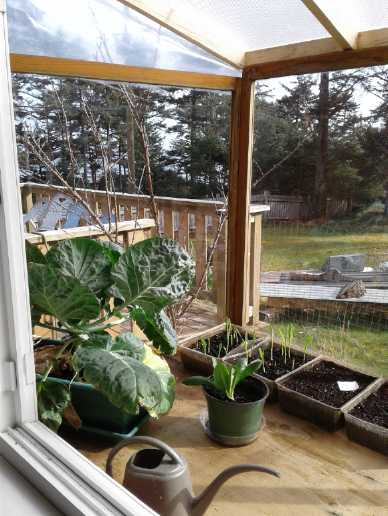
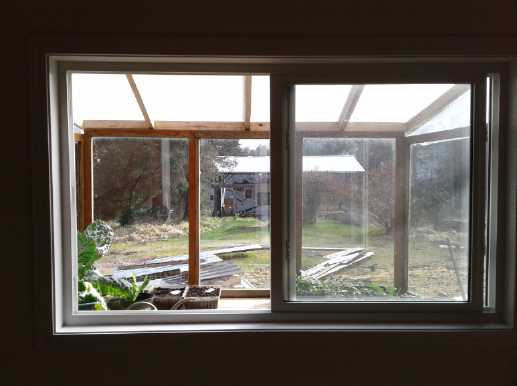
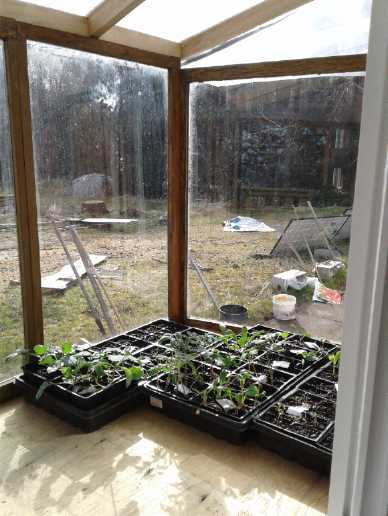
 In practice it seemed quite nice. It got nice and warm when the sun
was shining and was about neutral in clouds. But the cold draft coming
through once the sun departed led me to close the window most of the
way at night. I stapled in some polyethylene foam plastic as
weatherstripping, but unless I can make
it much better, or unless I get super cheap heat pumping going, I
think I'll forget about trying to keep it warm in winter.
In practice it seemed quite nice. It got nice and warm when the sun
was shining and was about neutral in clouds. But the cold draft coming
through once the sun departed led me to close the window most of the
way at night. I stapled in some polyethylene foam plastic as
weatherstripping, but unless I can make
it much better, or unless I get super cheap heat pumping going, I
think I'll forget about trying to keep it warm in winter.




 On the 21st the store called to say the baby chicks I had ordered the
previous month had hatched. I can't believe they all had the same
parents - two yellow, two somewhat stripey and two pretty dark. That
seemed like a good assortment. By the time I got them home the little
cardboard box was chirping piteously. I set up a plastic tote with
food, water and a heat lamp (all bought previously when I ordered them)
and once they had warmed up they seemed content.
On the 21st the store called to say the baby chicks I had ordered the
previous month had hatched. I can't believe they all had the same
parents - two yellow, two somewhat stripey and two pretty dark. That
seemed like a good assortment. By the time I got them home the little
cardboard box was chirping piteously. I set up a plastic tote with
food, water and a heat lamp (all bought previously when I ordered them)
and once they had warmed up they seemed content.



 I had been looking at "automatic
chicken coop doors" on line. I finally decided they didn't fit in with
my sled. Instead I'd make a door that the chickens open by stepping on
a peddle as they start stirring in the morning. I'll still have to
close it at night. (Darned if I'm getting up at the crack of dawn to
open a door for some chickens!) But I may make my own electronic one at
some point. Or buy one if it's still possible.
I had been looking at "automatic
chicken coop doors" on line. I finally decided they didn't fit in with
my sled. Instead I'd make a door that the chickens open by stepping on
a peddle as they start stirring in the morning. I'll still have to
close it at night. (Darned if I'm getting up at the crack of dawn to
open a door for some chickens!) But I may make my own electronic one at
some point. Or buy one if it's still possible. * A redheaded
woodpecker decided to start in on the back end of my house. I went out
and chased him off a few times, but he came back daily, early in the
morning, and started in again. ("Pellet gun" was suggested.) After a
couple of weeks he had a couple of big holes and had flung out little
bits of fiberglass insulation - all over, everywhere. Apparently he was
trying to make a nest but didn't like the stuffing. Finally I had had
enough and I went up on a ladder and screwed bits of wood over his
larger holes. Then I went out with the vacuum cleaner and eventually
managed to suck up all (?) the bits of insulation. (Yes I should deal
with that old door, too.)
* A redheaded
woodpecker decided to start in on the back end of my house. I went out
and chased him off a few times, but he came back daily, early in the
morning, and started in again. ("Pellet gun" was suggested.) After a
couple of weeks he had a couple of big holes and had flung out little
bits of fiberglass insulation - all over, everywhere. Apparently he was
trying to make a nest but didn't like the stuffing. Finally I had had
enough and I went up on a ladder and screwed bits of wood over his
larger holes. Then I went out with the vacuum cleaner and eventually
managed to suck up all (?) the bits of insulation. (Yes I should deal
with that old door, too.)
 * And then of course there's the main problem with
everything: the population bubble.
* And then of course there's the main problem with
everything: the population bubble.

